Cyprus is a beautiful country in the Mediterranean Sea. It’s the third largest island in the sea, but the 80th in the world. This breathtaking country is best known for its stunning blue waters, Haloumi cheese, and Commandaria, a sweet dessert wine. Cyprus has a rich history. It’s been conquered by many old empires, including the Assyrians, Arabs, Egyptians, Turks, and Persians.
Apart from its interesting history, delicious food, and amazing sights, Cyprus also has diverse flora and fauna. Many trees thrive in Cyprus, and long before humans settled on the island, lush forests covered the land. Although there are fewer forests than there used to be over 4,000 years ago, many native trees still exist in the country.
Follow along to learn about 7 incredible trees native to Cyprus.
1. Eastern Mediterranean Strawberry Tree (Arbutus andrachne)
The first tree on our list is the eastern Mediterranean strawberry tree. Another common name for this tree is the Greek strawberry tree. It’s native to the Mediterranean region and the Middle East. This tree is tall and has unique bark. For example, the bark is sometimes a pistachio green color, but it changes to orange-brown. Eastern Mediterranean strawberry trees produce many small and beautiful white or yellowish-green flowers. From the flowers come delicious fruit that when dried you can eat like a chewy candy.

Eastern Mediterranean strawberry trees are native to the Mediterranean region and the Middle East.
©Nadya Spektor/Shutterstock.com
2. Aleppo Oak (Quercus infectoria)
Another tree native to Cyprus is the Aleppo oak. This tree species is native throughout the Middle East and parts of southern Europe. It’s a small tree, that typically reaches between 3 to 6 feet tall. Aleppo oaks have bright green leaves and crooked stems. They also produce long and slender seeds. Aleppo oaks are best known for their galls. When gall wasps sting this tree and deposit their larvae, a gall arises on young branches.
Galls are abnormal outgrowths of plant tissue. Galls look different depending on the cause. The galls on Aleppo Oaks are bumpy, round, and hard. These abnormal growths contain high amounts of natural tannin. They also have many uses. Galls can be used in pharmaceuticals, medical laboratory techniques, dyes, and the tanning process. This tree is also used in traditional Indian medicine and dentistry for the treatment of toothache and gingivitis.
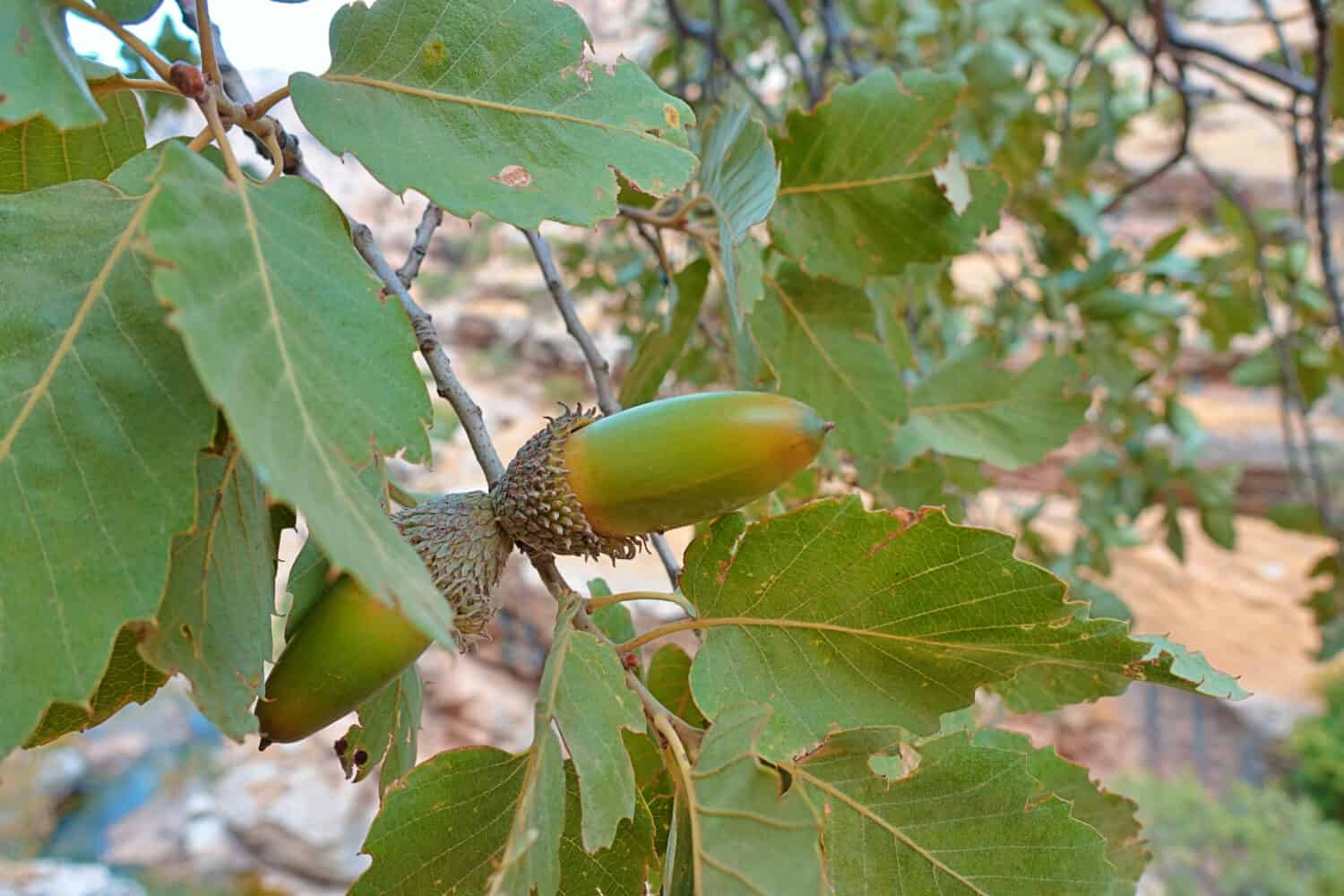
Aleppo oaks are native trees to Cyprus. You can also find them throughout southern Europe.
©Roy Poloi/Shutterstock.com
3. Carob Tree (Ceratonia siliqua)
The next native tree to Cyprus on our list is the carob tree. It’s found throughout the Mediterranean region and the Middle East. It’s a flowering evergreen tree with edible fruit ponds. However, it’s also planted in public gardens and parks as an ornamental plant. The edible fruit pods are cultivated in many parts of the world, but the largest producer is Portugal.
Carob trees are tall and have many thick branches. They can easily reach 50 feet and have 4 to 8-inch long leaves. The leaves are alternate, pinnate, and are different shades of green. Some leaves curl inward. While the fruits are called pods, they are legumes. It can take the pods about a year to ripen. Carob sweets are popular. The pulp is usually sold as flour used in baking. They are especially used in cookie and cake recipes since carob fruits are generally sweet. Farmers also give these pods to animals since they don’t contain caffeine or the chemical compound theobromine.
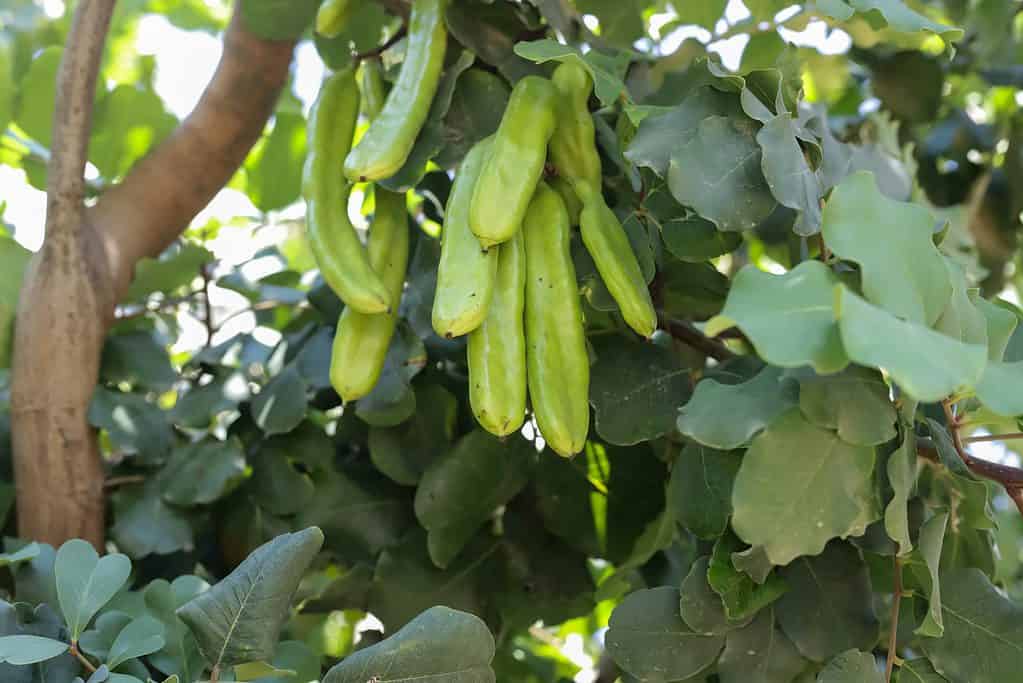
Another tree native to Cyprus is the carob, which is grown for its sweet fruit pods and as an ornamental tree.
©ibrahim kavus/Shutterstock.com
4. Calabrian Pine (Pinus brutia)
Another native Cyprus tree is the Calabrian pine, found throughout the eastern Mediterranean region. While found in Cyprus, this tree mostly grows in Turkey. Other names for the Calabrian pine are the Turkish pine, Brutia pine, or East Mediterranean pine. These medium-sized trees typically reach between 55 to 115 feet tall. They have thick trunks with a diameter of around 3.5 feet. The leaves are long and slender pine needles and the tree produces stout, hard, and heavy pinecones.
This tree species has many uses. For example, it plays a large role in pine honey production. The tree is host to the aphid, Marchalina hellenica, which secretes excess sugar. Afterward, honey bees collect the sugar and make it into valuable pine honey. The Calabrian pine is also the most important tree in forestry in Turkey and Cyprus. Its timber is used for firewood, carpentry, and general construction. While Turkish pines aren’t native to the United States, you can find them in California, New Mexico, Texas, and Utah as ornamental plants.
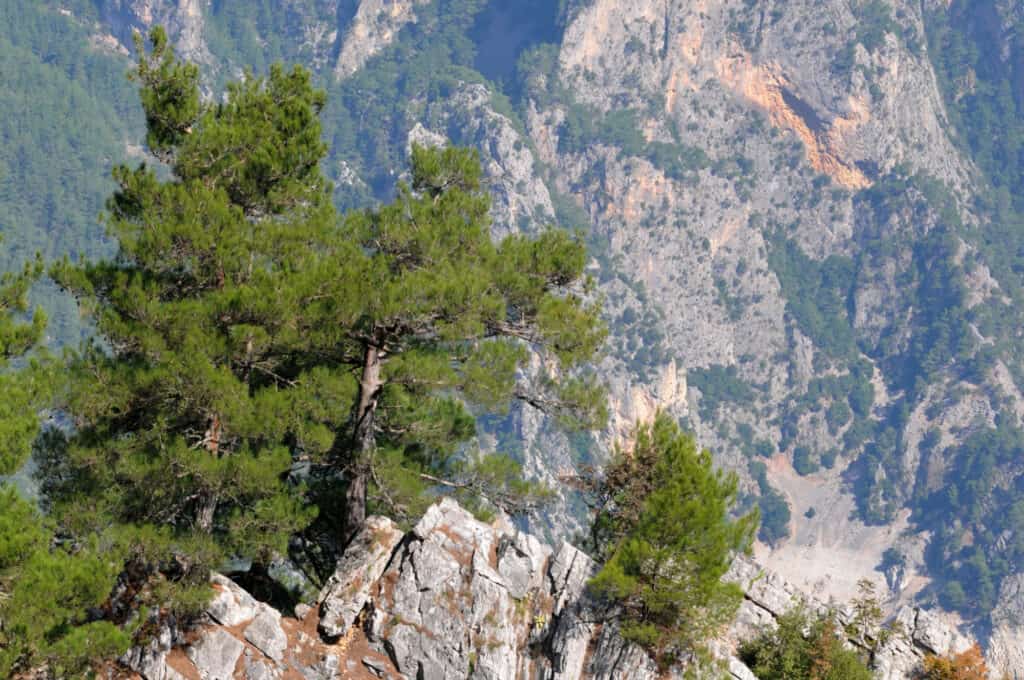
The
Pinus brutiais a native tree to Cyprus and it’s an important tree for forestry.
©zcebeci/Shutterstock.com
5. Common Cypress (Cupressus sempervirens)
The common cypress is a medium-sized coniferous evergreen tree, commonly known as the Mediterranean cypress, pencil pine, Persian cypress, Tuscan cypress, or Italian cypress. It’s native to the eastern Mediterranean region. Some trees you can find this species, include Croatia, Bulgaria, Albania, Bosnia, Italy, France, Spain, Syria, Palestine, Jordan, and Lebanon. Common cypress trees can reach up to 115 feet tall. They live long, with some reports suggesting they can live for over 1,000 years. The foliage of these trees is dense and dark. The cones are green, but turn brown as they mature.
Common cypress trees are beautiful and useful. They are popular ornamental trees in hot and dry places. While these trees are only native to the Mediterranean region, they’ve been introduced to southwest South Africa, southern Australia, the United States, the British Isles, and New Zealand. These trees have thick and durable wood. Common cypress timber was used for the doors of St. Peter’s Basilica in Vatican City, Rome.
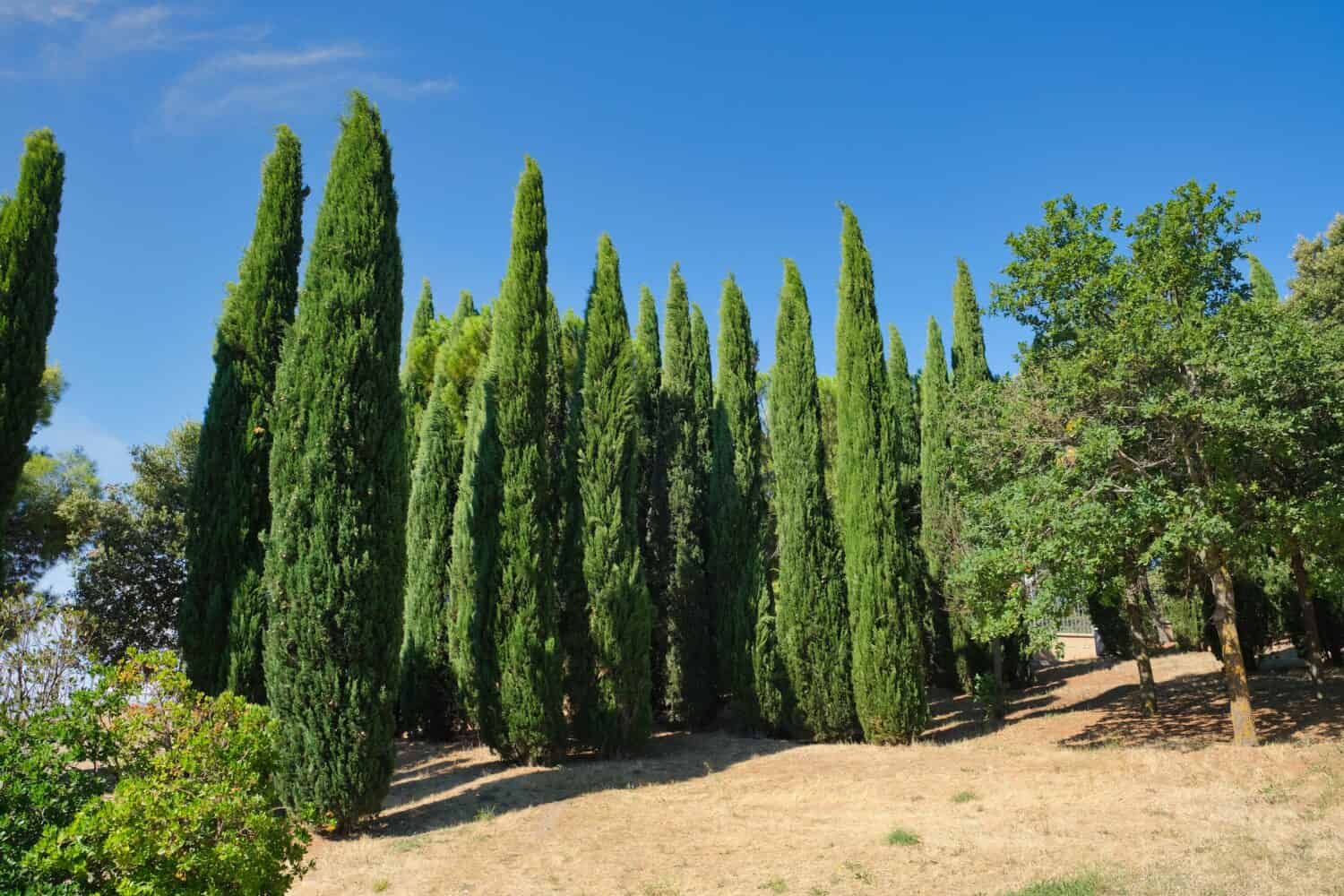
Common cypress trees have many names including the Mediterranean cypress, pencil pine, Persian cypress, Tuscan cypress, and Italian cypress.
©Wirestock Creators/Shutterstock.com
6. Common Olive (Olea europaea)
While most people think of Greece when they hear olive trees, the common olive is native across Mediterranean Europe, Asia, and Africa. These trees or shrubs usually reach about 25 to 30 feet tall. Common olive trees have silvery green leaves and produce small, white, feathery flowers. The fruits produced from this tree are small green to purple olives.
These trees have a long history and a lot of meaning. According to recent fossil findings, these trees have origins about 20 to 40 million years ago. However, they’ve been used by humans for about 100,000 years. The first recorded instance was in Africa, on the Atlantic coast of Morocco. Although this tree has existed in the Eastern Mediterranean since 19,000 BP, it was cultivated about 7,000 years ago. While olive trees are grown in the Americas, they aren’t native to the region. Instead, the Spanish brought olive trees during the 1500s. Common olive trees live long lives.
One of the oldest recorded olive trees is 3,350 years old and was planted at the beginning of the Atlantic Bronze Age in Portugal. Can you believe that it still lives today?

Common olive trees are native to Mediterranean Europe, Asia, and Africa. Some of the oldest living olive trees have lived for more than 2,000 years.
©jessicahyde/Shutterstock.com
7. Kermes Oak (Quercus coccifera)
There are many trees native to Cyprus, including the kermes oak. It’s a flowering oak bush or small tree within the Fagaceae family. Kermes oak trees are native to the Mediterranean region and Northern African Maghreb. Some countries within the native range are Portugal, Turkey, Libya, Spain, France, Morocco, and Greece. They rarely reach 6 feet tall and have many coriaceous leaves short green leaves. The acorns are small, usually less than an inch long or thick, and held in a scaly and prickly cup.
Kermes oaks mainly live in deserts. They like sunny slopes and can survive droughts and 16 to 24 inches of rainfall. The tallest Kermes tree ever recorded was about 55.7 feet tall in Kalopanagiotis. It’s also about 700 years old.
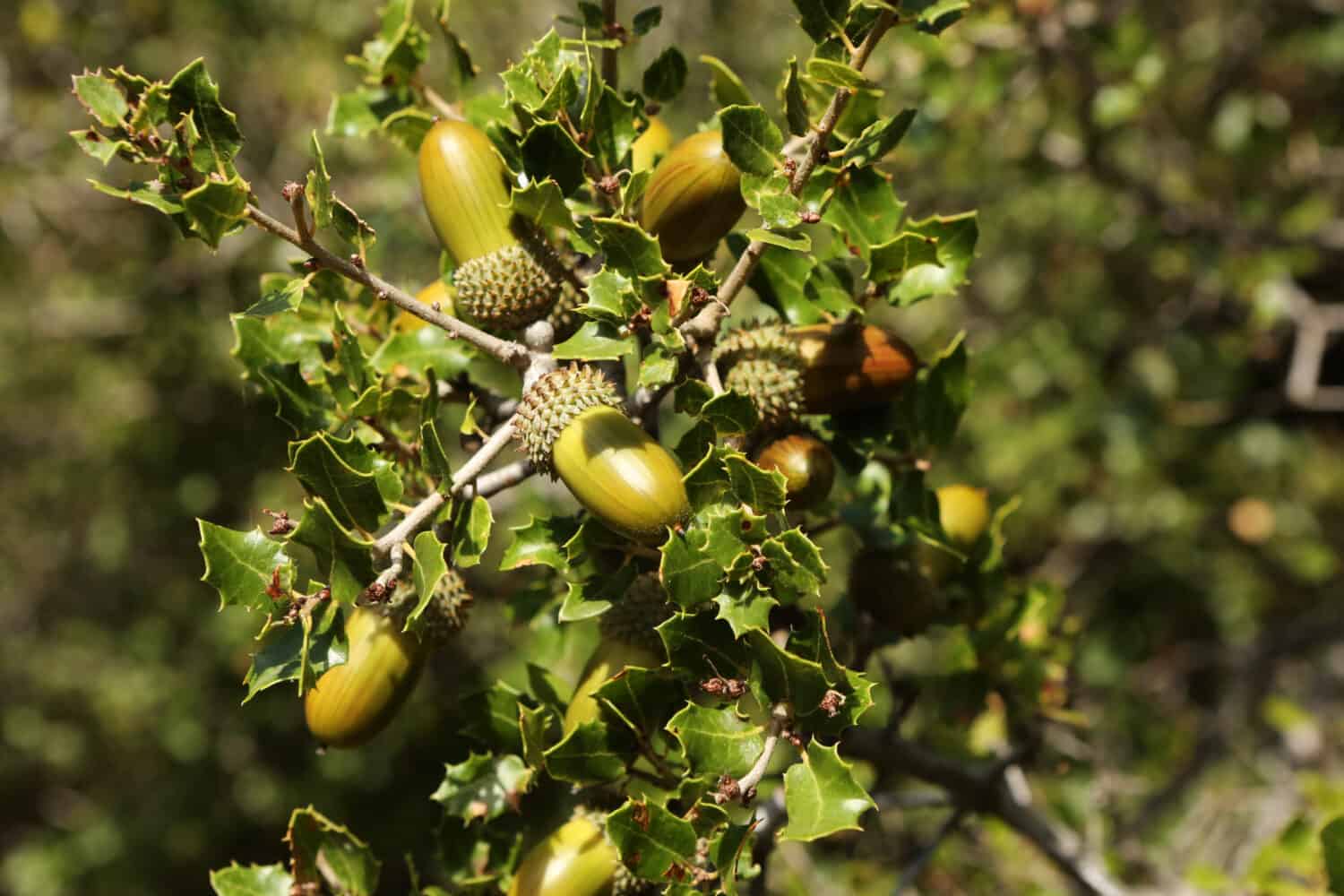
Kermes oaks are native to Cyprus and thrive in deserts and droughts. While they can live in rainy regions, they only tolerate rainfall between 16 to 24 inches.
©nndrln/Shutterstock.com
The photo featured at the top of this post is © iStock.com/Derek Brumby
Thank you for reading! Have some feedback for us? Contact the AZ Animals editorial team.






